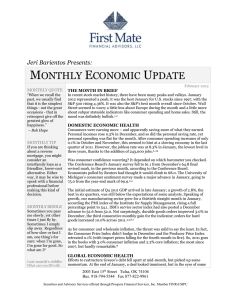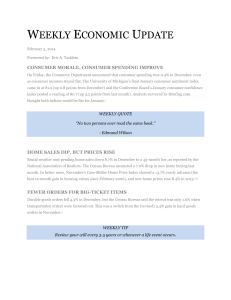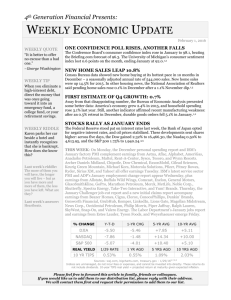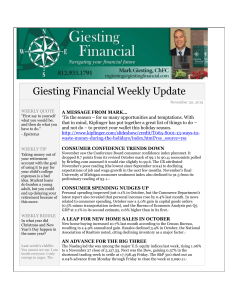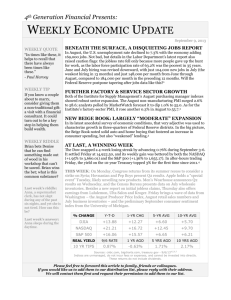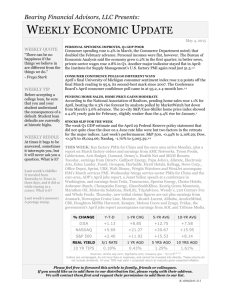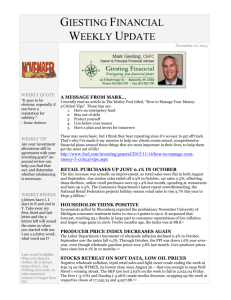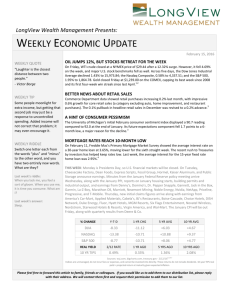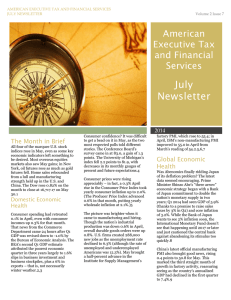Weekly Economic Update
advertisement
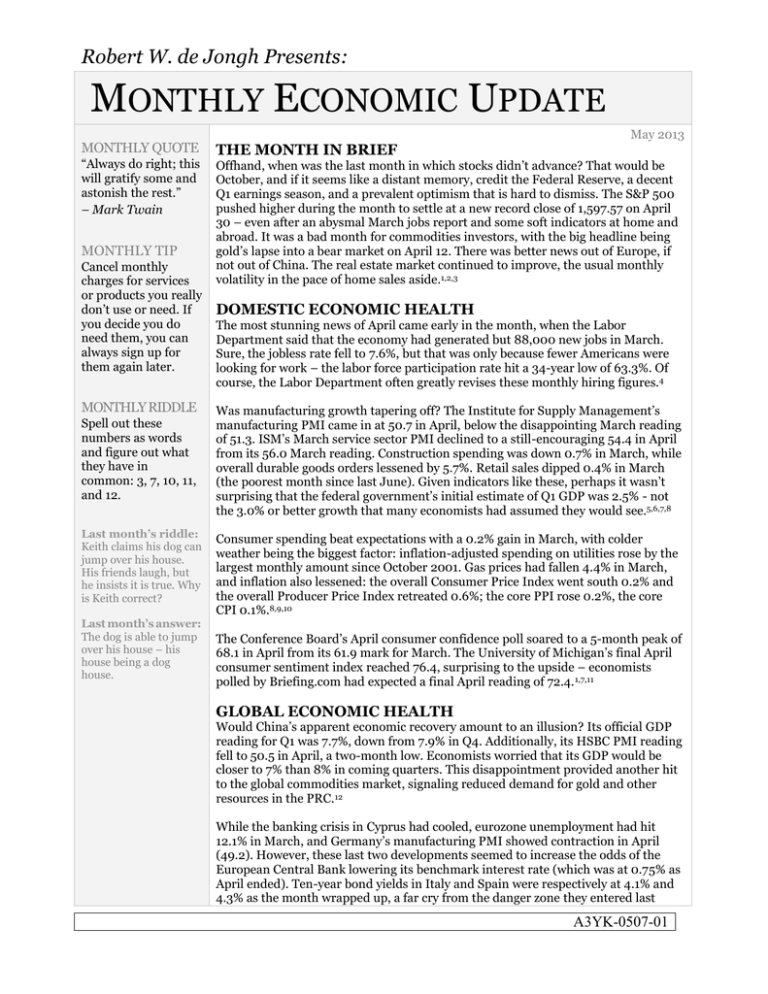
Robert W. de Jongh Presents: MONTHLY ECONOMIC UPDATE MONTHLY QUOTE “Always do right; this will gratify some and astonish the rest.” – Mark Twain MONTHLY TIP Cancel monthly charges for services or products you really don’t use or need. If you decide you do need them, you can always sign up for them again later. MONTHLY RIDDLE Spell out these numbers as words and figure out what they have in common: 3, 7, 10, 11, and 12. Last month’s riddle: Keith claims his dog can jump over his house. His friends laugh, but he insists it is true. Why is Keith correct? Last month’s answer: The dog is able to jump over his house – his house being a dog house. May 2013 THE MONTH IN BRIEF Offhand, when was the last month in which stocks didn’t advance? That would be October, and if it seems like a distant memory, credit the Federal Reserve, a decent Q1 earnings season, and a prevalent optimism that is hard to dismiss. The S&P 500 pushed higher during the month to settle at a new record close of 1,597.57 on April 30 – even after an abysmal March jobs report and some soft indicators at home and abroad. It was a bad month for commodities investors, with the big headline being gold’s lapse into a bear market on April 12. There was better news out of Europe, if not out of China. The real estate market continued to improve, the usual monthly volatility in the pace of home sales aside.1,2,3 DOMESTIC ECONOMIC HEALTH The most stunning news of April came early in the month, when the Labor Department said that the economy had generated but 88,000 new jobs in March. Sure, the jobless rate fell to 7.6%, but that was only because fewer Americans were looking for work – the labor force participation rate hit a 34-year low of 63.3%. Of course, the Labor Department often greatly revises these monthly hiring figures.4 Was manufacturing growth tapering off? The Institute for Supply Management’s manufacturing PMI came in at 50.7 in April, below the disappointing March reading of 51.3. ISM’s March service sector PMI declined to a still-encouraging 54.4 in April from its 56.0 March reading. Construction spending was down 0.7% in March, while overall durable goods orders lessened by 5.7%. Retail sales dipped 0.4% in March (the poorest month since last June). Given indicators like these, perhaps it wasn’t surprising that the federal government’s initial estimate of Q1 GDP was 2.5% - not the 3.0% or better growth that many economists had assumed they would see.5,6,7,8 Consumer spending beat expectations with a 0.2% gain in March, with colder weather being the biggest factor: inflation-adjusted spending on utilities rose by the largest monthly amount since October 2001. Gas prices had fallen 4.4% in March, and inflation also lessened: the overall Consumer Price Index went south 0.2% and the overall Producer Price Index retreated 0.6%; the core PPI rose 0.2%, the core CPI 0.1%.8,9,10 The Conference Board’s April consumer confidence poll soared to a 5-month peak of 68.1 in April from its 61.9 mark for March. The University of Michigan’s final April consumer sentiment index reached 76.4, surprising to the upside – economists polled by Briefing.com had expected a final April reading of 72.4. 1,7,11 GLOBAL ECONOMIC HEALTH Would China’s apparent economic recovery amount to an illusion? Its official GDP reading for Q1 was 7.7%, down from 7.9% in Q4. Additionally, its HSBC PMI reading fell to 50.5 in April, a two-month low. Economists worried that its GDP would be closer to 7% than 8% in coming quarters. This disappointment provided another hit to the global commodities market, signaling reduced demand for gold and other resources in the PRC.12 While the banking crisis in Cyprus had cooled, eurozone unemployment had hit 12.1% in March, and Germany’s manufacturing PMI showed contraction in April (49.2). However, these last two developments seemed to increase the odds of the European Central Bank lowering its benchmark interest rate (which was at 0.75% as April ended). Ten-year bond yields in Italy and Spain were respectively at 4.1% and 4.3% as the month wrapped up, a far cry from the danger zone they entered last A3YK-0507-01 summer; the yield on Spain’s 10-year note fell for an eighth straight month. Italy’s political stalemate ended after two months, with new prime minister Enrico Letta receiving a parliamentary vote of confidence.11,13,14,15 WORLD MARKETS Many marquee indices fared well in April. The gainers included the Global Dow (+3.27%), the MSCI World Index (+2.90%), the MSCI Emerging Markets Index (+0.44%), the Nikkei 225 (+11.80%), the Sensex (+3.55%), the S&P/ASX 200 (+4.52%), the FTSE 100 (+0.29%), the CAC 40 (+3.36%), the DAX (+1.52%) and the Euro STOXX 50 (+0.99%). In the loss column for April, we find the TSX Composite (-2.30%), the IPC All-Share (-4.11%), the Bovespa (-0.78%) and the Shanghai Composite (-2.62%).2,16 COMMODITIES MARKETS It wasn’t all bad in April: natural gas futures rose 9.0%, cocoa futures gained 9.1%, and wheat futures rose 6.3%. Now for the bad news: gold fell 7.8% last month to an April 30 COMEX close of just $1,474.00. Silver cratered 14.6% in April; copper fell 6.4%, platinum 4.3% and palladium 9.2%. Corn (-6.5%) and soybeans (-0.4%) both lost ground for a third consecutive month. NYMEX crude dipped 3.9% in April to end the month at $93.46 a barrel while RBOB gasoline futures dropped 9.8%. The U.S. Dollar Index lost 1.52% in April, settling at 81.72 on April 30. 11,17,18,19 REAL ESTATE The pace of existing home sales was 10.3% better in March 2013 than it was in March 2012, according to the National Association of Realtors; the Census Bureau reported an 18.5% year-over-year improvement in the pace of new home purchases. The February S&P/Case-Shiller Home Price Index showed its best overall 12-month gain since May 2006 (+9.3%). NAR also noted pending home sales at a 3-year peak in March, with the annual gain at 7.0%. Existing home sales did decline 0.6% in March; new home sales rose 1.5%.11,20,21 What happened to mortgage rates in April? We saw notable declines. Freddie Mac’s March 28 Primary Mortgage Market Survey had the average interest rate for the 30year FRM at 3.57%; it was at 2.76% for the 15-year FRM, 2.68% for the 5/1-year ARMs and 2.62% for the 1-year ARM. In the last April survey (April 25), the numbers were as follows: 30-year FRM, 3.40%; 15-year FRM, 2.61%; 5/1-year ARM, 2.58%; 1-year ARM, 2.62%.22 LOOKING BACK…LOOKING FORWARD The NASDAQ and S&P are now on 6-month winning streaks – the longest win streaks they have realized in the current bull market. The DJIA advanced for a fifth straight month in April. Here are the settlement prices from April 30: DJIA, 14,839.80; S&P, 1,597.57, NASDAQ, 3,328.79; Russell 2000, 947.46. (The RUT actually lost 0.43% for April.)1,2 % CHANGE YTD 1-MO CHG 1-YR CHG 10-YR AVG DJIA +13.25 +1.79 +12.31 +7.50 NASDAQ +10.24 +1.88 +9.27 +12.73 S&P 500 +12.02 +1.81 +14.28 +7.42 REAL YIELD 4/30 RATE 1 YR AGO 5 YRS AGO 10 YRS AGO 10 YR TIPS -0.64% -0.30% 1.50% 2.16% Sources: online.wsj.com, bigcharts.com, treasury.gov - 4/30/132,23,24 Indices are unmanaged, do not incur fees or expenses, and cannot be invested into directly. These returns do not include dividends. Hopefully, we won’t see domestic economic indicators falter in May and June, as was the case in 2011 and 2012. Overseas indicators (growth and manufacturing in A3YK-0507-01 China, the lingering recession in Europe) may not promise much, however. On a positive note, the Fed is still printing plenty of money and sticking to its accommodative monetary policy, which has boosted stocks of late more than any other factor. The undeniable psychological lift from the Fed’s open-ended easing hasn’t worn off, and investor morale is still high. The market doesn’t seem to be facing headwinds comparable to spring 2011 or spring 2012, though they certainly could arise. If the S&P does top 1,600 in the first half of May and close above 1,600 at the end of the month, you can’t say that Wall Street would be shocked. “Sell in May, go away?” Maybe not. Many investors still see more upside in this bull market. UPCOMING ECONOMIC RELEASES: For the balance of May, here is the schedule of consequential announcements ... the Labor Department’s April jobs report and the ISM April service sector index (5/3), March wholesale inventories (5/9), April retail sales (5/13), April’s PPI and industrial production and the May NAHB housing market index (5/15), the April CPI plus the report on April housing starts and building permits (5/16), the Conference Board’s April index of Leading Economic Indicators and the University of Michigan’s preliminary May consumer sentiment survey (5/17), April existing home sales and the release of the May 1 Fed minutes (5/22), April new home sales and March’s FHFA housing price index (5/23), April durable goods orders (5/24), the March Case-Shiller home price index and the Conference Board’s May consumer confidence poll (5/28), the second federal government estimate of Q1 GDP and NAR’s pending home sales report for April (5/30), and May’s final University of Michigan consumer sentiment survey plus the April consumer spending report (5/31). Please feel free to forward this article to family, friends or colleagues. If you would like us to add them to our distribution list, please reply with their address. We will contact them first and request their permission to add them to our list. A3YK-0507-01 «RepresentativeDisclosure» A3YK-0507-01 This material was prepared by MarketingLibrary.Net Inc., and does not necessarily represent the views of the presenting party, nor their affiliates. Marketing Library.Net Inc. is not affiliated with any broker or brokerage firm that may be providing this information to you. This information should not be construed as investment, tax or legal advice and may not be relied on for the purpose of avoiding any Federal tax penalty. This is not a solicitation or recommendation to purchase or sell any investment or insurance product or service, and should not be relied upon as such. The Dow Jones Industrial Average is a price-weighted index of 30 actively traded blue-chip stocks. The NASDAQ Composite Index is an unmanaged, market-weighted index of all over-the-counter common stocks traded on the National Association of Securities Dealers Automated Quotation System. The Standard & Poor's 500 (S&P 500) is an unmanaged group of securities considered to be representative of the stock market in general. It is not possible to invest directly in an index. NYSE Group, Inc. (NYSE:NYX) operates two securities exchanges: the New York Stock Exchange (the “NYSE”) and NYSE Arca (formerly known as the Archipelago Exchange, or ArcaEx®, and the Pacific Exchange). NYSE Group is a leading provider of securities listing, trading and market data products and services. The New York Mercantile Exchange, Inc. (NYMEX) is the world's largest physical commodity futures exchange and the preeminent trading forum for energy and precious metals, with trading conducted through two divisions – the NYMEX Division, home to the energy, platinum, and palladium markets, and the COMEX Division, on which all other metals trade. The Global Dow℠ is a 150-stock index of the most innovative, vibrant and influential corporations from around the world. The MSCI World Index is a free-float weighted equity index that includes developed world markets, and does not include emerging markets. The MSCI Emerging Markets Index is a float-adjusted market capitalization index consisting of indices in more than 25 emerging economies. Nikkei 225 (Ticker: ^N225) is a stock market index for the Tokyo Stock Exchange (TSE). The Nikkei average is the most watched index of Asian stocks. The BSE SENSEX (Bombay Stock Exchange Sensitive Index), also-called the BSE 30 (BOMBAY STOCK EXCHANGE)or simply the SENSEX, is a free-float market capitalization-weighted stock market index of 30 well-established and financially sound companies listed on the Bombay Stock Exchange (BSE). The S&P/ASX 200 index is a market-capitalization weighted and float-adjusted stock market index of Australian stocks listed on the Australian Securities Exchange from Standard & Poor's. The FTSE 100 Index is a share index of the 100 companies listed on the London Stock Exchange with the highest market capitalization. The CAC-40 Index is a narrow-based, modified capitalization-weighted index of 40 companies listed on the Paris Bourse. The DAX 30 is a Blue Chip stock market index consisting of the 30 major German companies trading on the Frankfurt Stock Exchange. The EURO STOXX 50 Index, Europe's leading Blue-chip index for the eurozone, provides a blue-chip representation of supersector leaders in the eurozone. The S&P/TSX Composite Index is an index of the stock (equity) prices of the largest companies on the Toronto Stock Exchange (TSX) as measured by market capitalization. The Bovespa Index is a gross total return index weighted by traded volume & is comprised of the most liquid stocks traded on the Sao Paulo Stock Exchange. The IPC All-Share is the main benchmark stock index of the Bolsa Mexicana de Valores (Mexican Stock Exchange) and is the broadest indicator of the BMV's overall performance. The SSE Composite Index is an index of all stocks (A shares and B shares) that are traded at the Shanghai Stock Exchange. The US Dollar Index measures the performance of the U.S. dollar against a basket of six currencies. Additional risks are associated with international investing, such as currency fluctuations, political and economic instability and differences in accounting standards. This material represents an assessment of the market environment at a specific point in time and is not intended to be a forecast of future events, or a guarantee of future results. Past performance is no guarantee of future results. Investments will fluctuate and when redeemed may be worth more or less than when originally invested. All information is believed to be from reliable sources; however we make no representation as to its completeness or accuracy. All economic and performance data is historical and not indicative of future results. Market indices discussed are unmanaged. Investors cannot invest in unmanaged indices. The publisher is not engaged in rendering legal, accounting or other professional services. If assistance is needed, the reader is advised to engage the services of a competent professional. Citations. 1 - money.cnn.com/2013/04/30/investing/stocks-markets/ [4/30/13] 2 - online.wsj.com/mdc/public/page/2_3024-m_globalstockindexes.html [4/30/13] 3 - marketwatch.com/story/gold-prices-slip-with-weekly-declines-in-sight-2013-04-12 [4/12/13] 4 - nytimes.com/2013/04/06/business/economy/us-adds-only-88000-jobs-jobless-rate-falls-to-7-6.html [4/5/13] 5 - cnbc.com/id/100694720 [5/1/13] 6 - ism.ws/ISMReport/NonMfgROB.cfm [4/3/13] 7 - briefing.com/investor/calendars/economic/2013/04/22-26 [4/26/13] 8 - nasdaq.com/article/us-stocks-slip-with-weak-consumer-sentiment-retail-data-20130412-00393#.UWhv1cpXqXk [4/12/13] 9 - reuters.com/article/2013/04/29/us-usa-economy-spending-idUSBRE93S0DV20130429 [4/29/13] 10 - 247wallst.com/2013/04/16/tame-march-cpi-supports-market-recovery/ [4/16/13] 11 - articles.marketwatch.com/2013-04-30/markets/38906878_1_oil-prices-barrels-interest-rate [4/30/13] 12 - cnbc.com/id/100662646 [4/22/13] 13 - iol.co.za/business/international/global-pmis-give-reasons-for-doubt-1.1505321 [4/24/13] 14 - bloomberg.com/news/2013-04-26/jpmorgan-sees-spanish-bond-gains-as-liquidity-fuels-rally-1-.html [4/26/13] 15 - cnn.com/2013/04/29/world/europe/italy-politics/ [4/29/13] 16 - mscibarra.com/products/indices/international_equity_indices/gimi/stdindex/performance.html [4/30/13] 17 - coinnews.net/2013/04/30/gold-and-silver-plummet-in-april-us-mint-bullion-coins-soar/ [4/30/13] 18 - bloomberg.com/news/2013-04-30/oil-falls-with-metals-aluminum-to-zinc-commodities-at-close.html [4/30/13] 19 - online.wsj.com/mdc/public/npage/2_3050.html?mod=mdc_curr_dtabnk&symb=DXY [5/1/13] 20 - csmonitor.com/Business/new-economy/2013/0423/New-home-sales-climb-1.5-percent-bolstering-housing-recovery [4/23/13] 21 - blogs.wsj.com/developments/2013/04/29/pending-home-sales-rose-in-march/ [4/29/13] 22 - freddiemac.com/pmms/ [5/1/13] 23 - bigcharts.marketwatch.com/historical/default.asp?symb=DJIA&closeDate=4%2F30%2F12&x=0&y=0 [4/30/13] 23 - bigcharts.marketwatch.com/historical/default.asp?symb=COMP&closeDate=4%2F30%2F12&x=0&y=0 [4/30/13] 23 - bigcharts.marketwatch.com/historical/default.asp?symb=SPX&closeDate=4%2F30%2F12&x=0&y=0 [4/30/13] 23 - bigcharts.marketwatch.com/historical/default.asp?symb=DJIA&closeDate=4%2F30%2F03&x=0&y=0 [4/30/13] 23 - bigcharts.marketwatch.com/historical/default.asp?symb=COMP&closeDate=4%2F30%2F03&x=0&y=0 [4/30/13] 23 - bigcharts.marketwatch.com/historical/default.asp?symb=SPX&closeDate=4%2F30%2F03&x=0&y=0 [4/30/13] 24 - treasury.gov/resource-center/data-chart-center/interest-rates/Pages/TextView.aspx?data=realyieldAll [5/1/13] A3YK-0507-01 A3YK-0507-01

